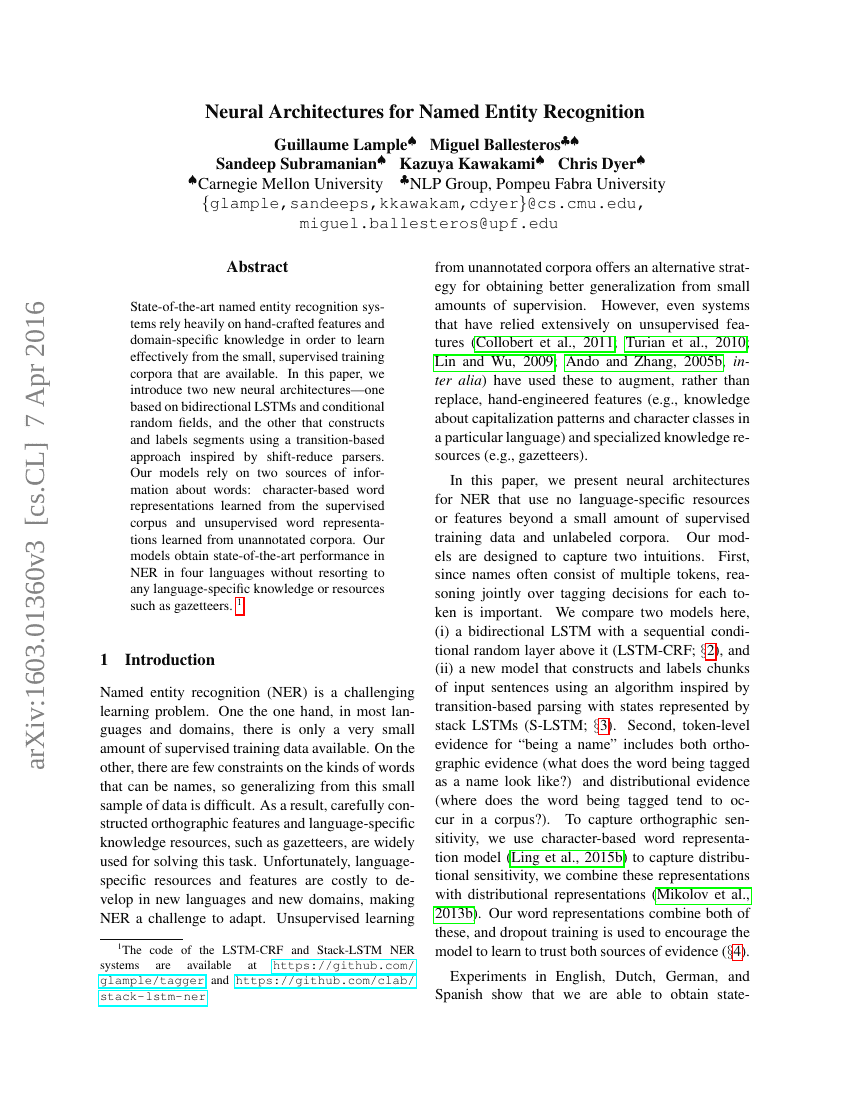
摘要
最先进的命名实体识别系统在学习时严重依赖手工特征和领域特定知识,尤其是在可用的小规模监督训练语料库中。本文介绍了两种新的神经架构——一种基于双向LSTM(长短期记忆网络)和条件随机场,另一种则采用受移位-归约分析器启发的基于转换的方法来构建和标记片段。我们的模型依赖于关于词语的两个信息来源:从监督语料库中学到的基于字符的词表示和从未标注语料库中学到的无监督词表示。这两种模型在四种语言的命名实体识别任务中取得了最先进的性能,而无需借助任何特定语言的知识或资源,如地名词典。
代码仓库
JZ-LIANG/CRF-LSTM-NER
tf
GitHub 中提及
vunb/anago-tagger
GitHub 中提及
flairNLP/flair
pytorch
GitHub 中提及
zjy-ucas/ChineseNER
tf
GitHub 中提及
maviccprp/ger_ner_evals
GitHub 中提及
UcasLzz/ChineseWordSeg-POS
GitHub 中提及
PKU-TANGENT/nlp-tutorial
pytorch
GitHub 中提及
IBM/MAX-Named-Entity-Tagger
tf
GitHub 中提及
Hironsan/anago
GitHub 中提及
IsabelMeraner/BotanicalNER
GitHub 中提及
samueljamesbell/sequence-labeler
tf
GitHub 中提及
wzzzd/LM_NER
pytorch
GitHub 中提及
deepmipt/DeepPavlov
tf
GitHub 中提及
SaeedNajafi/ac-tagger
pytorch
GitHub 中提及
HuihuiChyan/BJTUNLP_Practice2021
pytorch
GitHub 中提及
brendanxwhitaker/tagger-v
GitHub 中提及
guillaumegenthial/tf_ner
tf
GitHub 中提及
achernodub/targer
pytorch
GitHub 中提及
aymara/lima-tfner
tf
GitHub 中提及
Coda-s/BJTU_NLP_Practice
pytorch
GitHub 中提及
tahoora/BiLSTM-CRF
GitHub 中提及
HuihuiChyan/BJTUNLP_Practice2020
pytorch
GitHub 中提及
guillaumegenthial/sequence_tagging
tf
GitHub 中提及
karlstratos/mention2vec
GitHub 中提及
luopeixiang/named_entity_recognition
pytorch
GitHub 中提及
autoih/runtime_ner
tf
GitHub 中提及
zysite/post
pytorch
GitHub 中提及
yyHaker/NamedEntityRecognition
tf
GitHub 中提及
devkotasabin/EBM-NLP
GitHub 中提及
glample/tagger
官方
GitHub 中提及
gitzgk/nlp-beginner
tf
GitHub 中提及
thukg/query-entity-recognition
GitHub 中提及
marekrei/sequence-labeler
tf
GitHub 中提及
riedlma/sequence_tagging
tf
GitHub 中提及
Akshayanti/supersense-sequence-labelling
GitHub 中提及
clab/stack-lstm-ner
官方
GitHub 中提及
davidalbertonogueira/NLP-tutorials
pytorch
GitHub 中提及
deepmipt/ner
tf
GitHub 中提及
基准测试
| 基准 | 方法 | 指标 |
|---|---|---|
| named-entity-recognition-ner-on-conll-2003 | LSTM-CRF | F1: 90.94 |
| named-entity-recognition-on-conll | LSTM-CRF | F1: 91.47 |